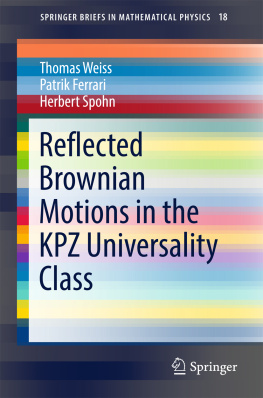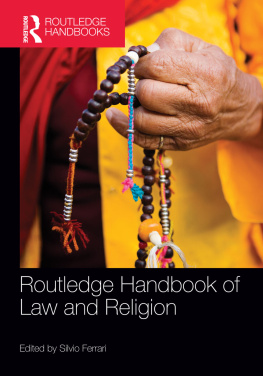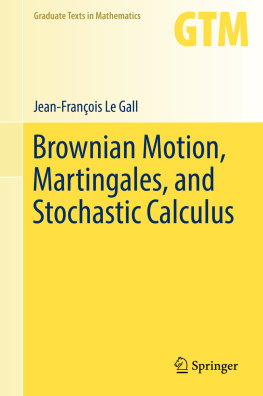Ferrari Patrik L. - Reflected Brownian Motions in the KPZ Universality Class
Here you can read online Ferrari Patrik L. - Reflected Brownian Motions in the KPZ Universality Class full text of the book (entire story) in english for free. Download pdf and epub, get meaning, cover and reviews about this ebook. City: Cham;Switzerland, year: 2017, publisher: Springer International Publishing;Springer Nature, genre: Home and family. Description of the work, (preface) as well as reviews are available. Best literature library LitArk.com created for fans of good reading and offers a wide selection of genres:
Romance novel
Science fiction
Adventure
Detective
Science
History
Home and family
Prose
Art
Politics
Computer
Non-fiction
Religion
Business
Children
Humor
Choose a favorite category and find really read worthwhile books. Enjoy immersion in the world of imagination, feel the emotions of the characters or learn something new for yourself, make an fascinating discovery.
- Book:Reflected Brownian Motions in the KPZ Universality Class
- Author:
- Publisher:Springer International Publishing;Springer Nature
- Genre:
- Year:2017
- City:Cham;Switzerland
- Rating:5 / 5
- Favourites:Add to favourites
- Your mark:
Reflected Brownian Motions in the KPZ Universality Class: summary, description and annotation
We offer to read an annotation, description, summary or preface (depends on what the author of the book "Reflected Brownian Motions in the KPZ Universality Class" wrote himself). If you haven't found the necessary information about the book — write in the comments, we will try to find it.
Ferrari Patrik L.: author's other books
Who wrote Reflected Brownian Motions in the KPZ Universality Class? Find out the surname, the name of the author of the book and a list of all author's works by series.













 ,
,  ,
,  . The equation reads
. The equation reads 

 . Then
. Then 
 is the n -particle Lieb-Liniger hamiltonian
is the n -particle Lieb-Liniger hamiltonian 
 signalling a similarity with quantum spin chains. In fact, the ASEP generator can be viewed as the Heisenberg chain with an imaginary XY-coupling. For the totally asymmetric limit (TASEP) and half filled lattice, Gwa and Spohn () established that the spectral gap of the generator is of order
signalling a similarity with quantum spin chains. In fact, the ASEP generator can be viewed as the Heisenberg chain with an imaginary XY-coupling. For the totally asymmetric limit (TASEP) and half filled lattice, Gwa and Spohn () established that the spectral gap of the generator is of order  . The same order is argued for the KPZ equation. This led to the strong belief that, despite their very different set-up, both models have the same statistical properties on large space-time scales. In the usual jargon of statistical mechanics, both models are expected to belong to the same universality class, baptized KPZ universality class according to its most prominent representative.
. The same order is argued for the KPZ equation. This led to the strong belief that, despite their very different set-up, both models have the same statistical properties on large space-time scales. In the usual jargon of statistical mechanics, both models are expected to belong to the same universality class, baptized KPZ universality class according to its most prominent representative. in the limit
in the limit  , (ii) flat ,
, (ii) flat ,  , and (iii) stationary ,
, and (iii) stationary ,  with B ( x ) two sided Brownian motion. The quantity of prime interest is the distribution of h (0, t ) for large t . More ambitiously, but still feasible in some models, is the large time limit of the joint distribution of
with B ( x ) two sided Brownian motion. The quantity of prime interest is the distribution of h (0, t ) for large t . More ambitiously, but still feasible in some models, is the large time limit of the joint distribution of  .
.
 a collection of independent standard Brownian motions. For the parameter
a collection of independent standard Brownian motions. For the parameter  we will eventually consider only the limit
we will eventually consider only the limit  . But for the purpose of our discussion we keep
. But for the purpose of our discussion we keep  finite for a while. In fact there is no choice, no other system of this structure is known to be integrable. The index set depends on the problem, mostly we choose
finite for a while. In fact there is no choice, no other system of this structure is known to be integrable. The index set depends on the problem, mostly we choose  . Note that
. Note that  interacts only with its left index neighbor
interacts only with its left index neighbor  . The drift depends on the slope, as it should be for a proper height function. But the exponential dependence on
. The drift depends on the slope, as it should be for a proper height function. But the exponential dependence on  is very special, however familiar from other integrable systems. The famous Toda chain (Toda ).
is very special, however familiar from other integrable systems. The famous Toda chain (Toda ).
 . These are non-reversible diffusion processes. Only in the symmetric case,
. These are non-reversible diffusion processes. Only in the symmetric case,  , the drift is the gradient of a potential and the diffusion process is reversible. Then the model is no longer in the KPZ universality class and has very distinct large scale properties, see Guo et al. (), for example.
, the drift is the gradient of a potential and the diffusion process is reversible. Then the model is no longer in the KPZ universality class and has very distinct large scale properties, see Guo et al. (), for example.